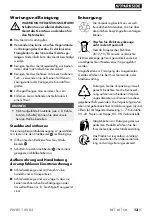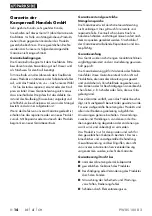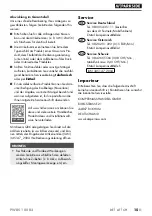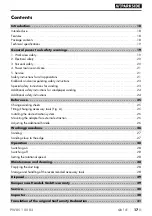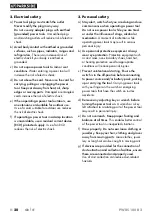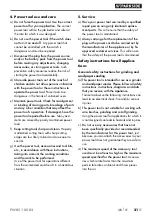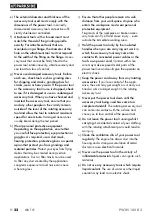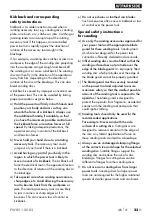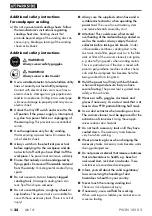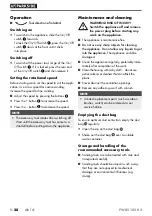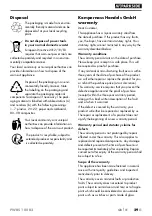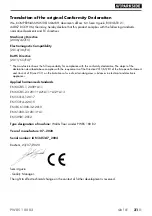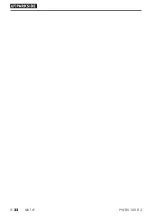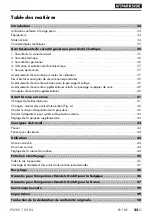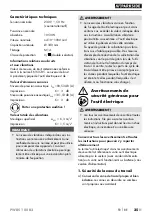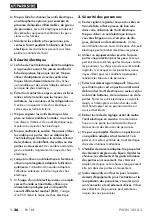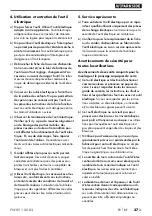
PWBS 180 B2
■
22
│
GB
│
IE
e)
The external diameter and thickness of the
accessory tool used must comply with the
dimensions of the power tool.
Incorrectly
dimensioned accessory tools cannot be suffi-
ciently shielded or controlled.
f)
Attachment tools with a thread insert must
match the thread of the grinding spindle
exactly. For attachment tools that are
mounted using a flange, the diameter of the
hole on the attachment tool must correspond
to the width of the fitting on the flange.
Acces-
sory tools that cannot be firmly fitted to the
power tool rotate unevenly, vibrate severely and
can lead to a loss of control.
g)
Never use damaged accessory tools. Before
each use, check tools such as grinding discs
for chipping and cracks, grinding discs for
cracks, wear or heavy wear. If the power tool
or the accessory tool in use is dropped, check
to see if it is damaged or use an undamaged
accessory tool. When you have checked and
inserted the accessory tool, ensure that you
and any other people in the vicinity remain
outside of the level of the rotating accessory
tool and allow the tool to rotate at maximum
speed for one minute.
Damaged accessories
usually break during the test period.
h)
Wear personal protective equipment.
Depending on the application, ensure that
you use full face protection, eye protection or
goggles. As required, use a dust mask,
hearing protection, protective gloves or special
apron that protect you from grindings and
material particles.
Protect your eyes from flying
debris that may be created during certain
applications. Dust or filter masks must be used
to filter any dust created by the application.
Long-term exposure to loud noise can cause
a hearing loss.
i)
Ensure that other people remain at a safe
distance from your workspace. Anyone who
enters the workspace must wear personal
protective equipment.
Fragments of the workpiece or broken acces-
sory tools can fly off and cause injury – even
outside the immediate working area.
j)
Hold the power tool only by the insulated
handles when you are carrying out work in
which the accessory tool may come into
contact with concealed power cables or the
tool’s own power cord.
Contact with a live
wire may make exposed metal parts of the
power tool live and could give the operator an
electric shock.
k)
Keep the power cord away from any rotating
accessories.
If you lose control of the appli-
ance, the cord may get caught or cut and your
hand or arm could get caught in the rotating
accessory tool.
l)
Never put the power tool down until the
accessory tool being used has come to a
complete standstill.
The rotating accessory tool
can come into contact with the surface and
cause you to lose control of the power tool.
m)
Do not leave the power tool running whilst
carrying it.
Accidental contact of your clothing
with the rotating attachment part could lead to
an injury.
n)
Clean the ventilation slits of your power tool
regularly.
The engine fan draws dust into the
housing and a strong accumulation of metal
dust can cause electrical hazards.
o)
Never use the power tool in the vicinity of
inflammable materials.
Sparks can ignite such
materials.
p)
Do not use any accessory tools which require
liquid coolant.
The use of water or other liquid
coolants may lead to an electric shock.
Summary of Contents for PWBS 180 B2
Page 3: ......
Page 4: ...A B 19a 18a...
Page 36: ...PWBS 180 B2 32 GB IE...
Page 102: ...PWBS 180 B2 98 CZ...






